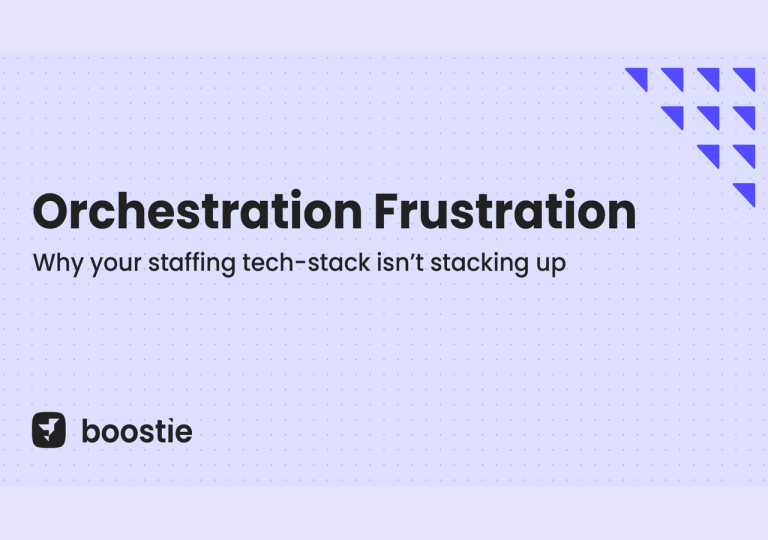Pop quiz: what do all successful staffing agencies have in common?
They know how to appeal to and inspire candidates— both active and passive— in a way that outshines the competition and builds an exceptional talent pool.
Recruitment marketing is the best way to reach passive and active candidates alike by piquing their interest in your services, providing desirable opportunities that can boost their careers and grow their skills, and making it clear you put their needs and goals above transactional placements.
Thinking like a recruitment marketer allows you to sell candidates on your services by using tailored content, personalized nurture campaigns, and long-term, multi-channel engagement strategies based on specific, achievable organizational goals. Our clients who have an effective recruitment marketing plan consistently see these benefits:
- Diversified pipelines filled with more qualified applicants
- Reduced time-to-hire
- Elevated candidate experience
- Increased employee engagement and retention
Define Your Recruitment Marketing Goals and Target Audience
Before you begin working on any other marketing component, define your organizational goals. It’s not enough to simply say you want to build a talent pool of quality candidates—so does everyone else. What can your firm offer jobseekers that others can’t? Including the how with the what is the key to creating a tangible goal.
Try using the SMART goals approach when determining how you can best showcase your brand to your clients and candidates through your marketing, as well as meet the needs of your own company. To be prepared for changing business needs or fluctuating labor market conditions, it’s important to set achievable deadlines for your goals— aim for the end of the quarter or in a few months’ time.
While there’s no one right answer for the best way to market your staffing agency, key factors can boost your brand. Here are our top five.
5 Recruitment Marketing Strategies for Attracting Top Talent
Once you’ve defined your organizational goals, begin by aligning your marketing goals with your recruiting goals. Encourage collaboration between your marketing team and recruiters to determine where there are chokepoints and bottlenecks in their ability to get the brand presence to attract candidates and fill your talent pool.
Step 1: Optimize Your Website for Jobseekers
Your prospects need to know they can trust you—this starts with your website. Tech-savvy candidates expect a modern, user-friendly design that allows them to intuitively find all the information they need about your company: who you are, what you do, and where they can search for open jobs.
Not only is an efficient job board a great branding opportunity, by housing a portal on your own site you can lower cost-per-hire, reduce fill time, drive candidate traffic, and bring in more qualified applicants.
To ensure your website and job portal are being seen by your intended audience, optimize them for search engines. Google’s ultimate goal is to answer its users’ questions efficiently and effectively. Make your staffing and recruiting website the answer to candidates searching for open positions by:
- Providing great usability to keep candidates on your page (e.g., high page speed, responsive design elements, etc.)
- Using trending keywords in your site copy and content, signaling to search engines that you’re providing relevant solutions to candidates
- Consistently posting high-quality, timely blog and social content to keep jobseekers’ attention
- Gaining backlinks from other reputable sources—when other high-value sources share your content, it boosts your SEO value
- Having a solid a backend architecture for your website, making your site easily navigable
Since search engine algorithms are ever evolving, set up analytics to see how your visitors interact with your webpages and be ready to make changes if you spot signs of friction like high bounce rates or partial form fills. Keeping up with current SEO trends and best practices will allow your business to stay ahead of the curve.
Step 2: Create Recruitment Marketing Content
Content that informs and engages your audience in ways unique to your brand and capable of resolving candidate career questions or concerns is the key to making your company stand out. Plan a steady, relevant stream of blog and social posts in advance that engages your target audience and represents your brand in the best light. Create a healthy balance of content directed at candidates in each stage of their buyer’s journey. So, you’ll reach prospects who are just learning about your company and services as well as those who know your brand well already.
Engaging content comes in many forms:
- Newsletters and company update emails
- Blog and social posts
- Videos and webinars
- Infographics
- Employee, client, and candidate testimonials
- Podcasts
- Events
Consider asking your current clients to contribute to blog and social posts about specific projects that went well or about their overall experience with your company—this is a great way to promote what’s great about both your organizations. You might also request video testimonials from employees sharing why they love being recruiters or ask for feedback from former or current candidates on their experience job searching with your firm.
No matter the type of content you share, make sure it’s something job seekers can engage with, and each article incorporates SEO best practices. Moving forward, you’ll build your brand’s credibility and candidates’ trust. The more value you provide in your content, the more likely your audience will remember you.
Step 3: Engage with Your Audience on Social Media
The vast majority of your prospective candidates are on social media and online job search platforms. Instead of waiting for your audience to find you, meet them where they are by encouraging passive talent to connect with your brand across social media. Wherever your target audience spends the most time online, your company should have a profile with curated content there as well, be it LinkedIn, Facebook, Instagram, Twitter, TikTok, or YouTube. Additionally, you can boost your credibility by updating non-career-related profiles like Google Business and Yelp.
Generate top-of-mind awareness for your audience by routinely posting a variety of content to each platform, keeping up with each app’s current trends and posting style. For example, LinkedIn is great for long-form text posts of case studies or testimonials, but Instagram is better for branded imagery and infographics. Consistent social media posting creates great organic traffic, but it’s also beneficial to run paid ads. By doing so, you can increase views on specific content to reach your target demographic.
One of the best ways to boost your brand on social media is by harnessing the power of your own employees. Notify your team via an application like Paiger each time you post a new blog or interesting content to social media and ask them to share the posts with their networks. This will not only boost views and engagement on your posts, but it will also make your company look more cohesive and close-knit.
On all platforms, respond and engage with your viewers if they leave comments or send messages—especially any negative reviews. Respond to those comments with tact and offer to chat further with them about the issue they experienced. Additionally, platforms like Great Recruiters allow your business to proactively ask for feedback; you can leverage these reviews to build trust with your audience and improve recruiter performance. Always come the table with solutions. Check your social media analytics often to see what posts are performing well and continue to post similar content. As your current or potential candidates see you on their feeds and in their inboxes, they’re more likely to think of you when they’re job searching.
Step 4: Boost Your Brand with Events
This may not apply to all staffing firms depending on the line of business and remote nature of some talent pools. However, when possible, conferences and trade shows can be incredibly effective as you’re working to share your brand with candidates. Your first step? Find events your ideal prospects are already attending and decide if the event’s theme is something relevant to their interests. Then, you can begin building recruitment marketing strategies unique to those you’re hoping to network with.
The best way to get the most attention from your desired audience is to be a speaker at the event. After applying and being accepted as a speaker, you should begin building a marketing campaign to announce your presentation and invite guests. Send emails to prospects and advertise with conference promotional materials, paid advertising on social media, and organic promotion of your presentation on social media. Speak on a topic that’s relevant to your ideal jobseeker. If you don’t get accepted as a speaker or aren’t interested in speaking, it’s also possible— and recommended— to build a campaign around any event you’re simply attending.
To position yourself as an expert in all things your candidates care about, include valuable conference content in your newsletter and write blog posts about your key knowledge session takeaways or speech highlights. Event-related content boosts SEO, is valuable to those who did and did not attend the conference and builds your credibility as a well-rounded industry expert. By participating in events, you give jobseekers the impression that you can not only offer value to them, but also to the industry as a whole.
Step 5: Nurture Your Prospects by Using Automation
Arguably the most important step in your strategy when it comes to winning over passive jobseekers is a personalized, segmented nurture campaign. This recruitment marketing strategy is the key to engaging talent and moving them further along in their candidate journey. Craft your messaging to make each individual job seeker feel heard and seen, always considering their interests, challenges, and goals.
Set up automated outreach to keep your company top-of-mind and to increase professionals’ interest in working with your team. No need to spam—one or two emails per month keeps your line of communication open and builds trust. Here is where your employer brand has the most potential to shine; nurture campaigns demonstrate your company understands your audience’s pain points and aligns with their values.
Every Staffing Firm’s Strategy Is Unique
The “best” marketing strategy for a staffing agency will be unique to each company, but they all begin with asking the right questions and assessing your brand’s goals. Take time to track your audience’s feedback during campaigns and compare your advertising metrics and hiring data from your CRM to your hiring benchmarks. If one strategy isn’t working, it’s okay to change course. Even the most successful recruitment marketing tactics will need to be updated over time as platforms and candidate preferences evolve. By implementing our suggestions, you’ll be equipped to handle even the most challenging of hiring markets.
This article was originally published in Echogravity.












